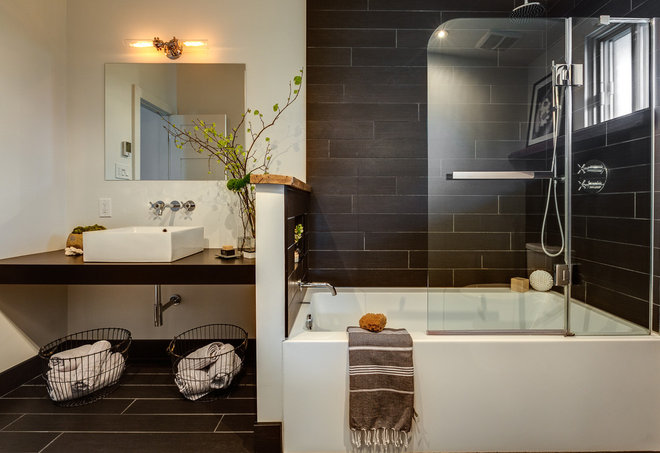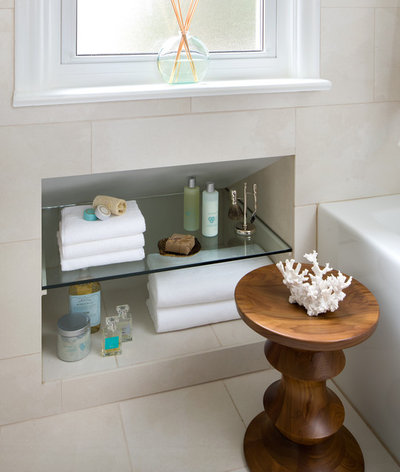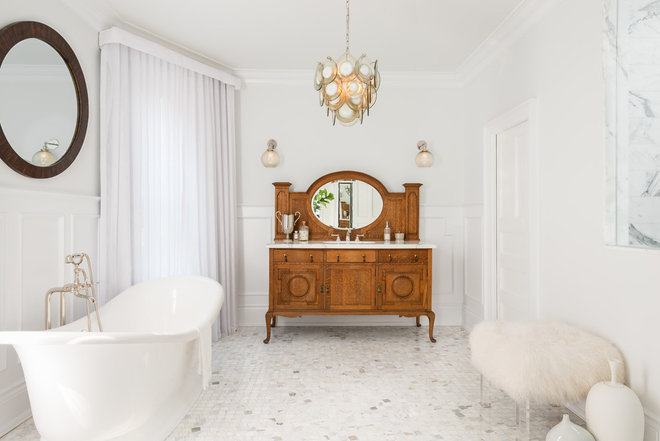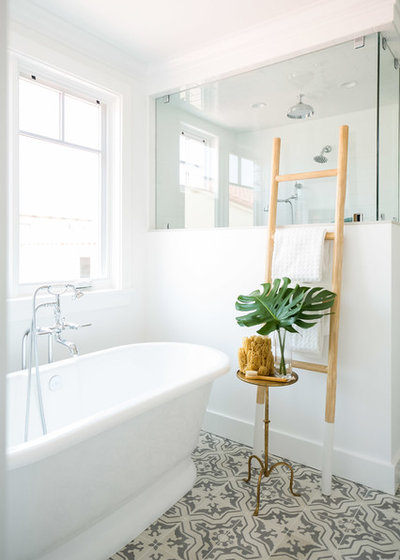How to Design a Warm, Welcoming Bathroom for Today
How to Design a Warm, Welcoming Bathroom for Today
Get ideas for materials, tile, color and more to give your bath fresh style
Does your bathroom feel a little too chilly? A little dated? Somewhere between modern minimalist masterpieces and cozy country design we find the popular style of bathroom that manages to feel cool and up-to-date but also warm and welcoming. To achieve this careful balance of seemingly disparate design demands, here is a design recipe for bringing warm, welcoming updates to your home bathroom.
Enticing Stone Tile
Naturally, in any bathroom space, a fundamental part of the design will be the tile. For that welcoming, “spa-like” look, nothing beats an element of stone tile. It looks beautiful and feels satisfying to the touch, while also being highly functional. If the budget allows, including some stone in the design, either as a singular material or contrasted against other porcelain tiles, will bring a lot of richness to the palette and a sense of sophistication.
Even if you choose not to tile all of the wall surfaces, I recommend having at least one area tiled floor to ceiling in some form of tile, with other walls bare, as opposed to having all of the walls tiled up to the same minimal height. This creates a finished look, with the contrast between the tiled walls and bare walls appearing intentional.
Palette
To make a bathroom feel inviting but airy, and warm but also contemporary and clean, it’s important to achieve balance. Using a lot of white or crisp just-off-white will make the room feel larger and lend pleasing contrast to warm elements.
Texture
One key part of a design palette that sometimes gets overlooked is rich, inviting texture, and this element is especially easy to forget about in a bathroom space, with its many hard, glossy surfaces.
You can see here how this space has a very simple color palette but already looks inviting just from the elements of grassy woven textures.
Wood
One of the best ways to add texture to a space is to introduce a healthy dose of wood through elements such as the vanity, shelving, furniture pieces (like an accent stool) or small accessories. Wood brings an inherent sense of natural elegance that comes through whether the wood is just lightly stained or hard-lacquered.
Furniture-Style Vanity
Sleek bathroom vanities can be beautifully simple in a modern space, but to add some warmth and personality, consider using a traditional or vintage furniture piece instead. After all, almost any furniture item, from an antique chest of drawers to an old kitchen island cart, can be retrofitted to become a vanity as long as it is the right height and is sturdy enough to hold a sink. A good craftsperson can advise you whether a piece you have or are shopping for can be converted, or you can look for captivating creations at local fairs.
Color
You may have read about how certain colors are “warm” (like reds, oranges and yellows) and other colors are “cool” (like blues, many purples and a lot of greens). However in practice, any color that makes you happy can make a space feel more warm, and a dose of color of almost any kind can make a space feel more welcoming. For example, this bathroom uses a cool blue wallpaper, but the result is friendly and fun, not chilly.
In-Floor Heating
If you want to make the room feel a lot warmer physically without jacking up your heating bills, consider installing an in-floor heating system during a renovation. Heat radiating upward from the floor will make the space feel warm even if the overall space isn’t technically heated to as high a temperature as with typical heating systems — plus you won’t have to deal with icy-cold floors on your bare toes.
Pattern
Not a fan of bold colors? A bit of graphic pattern is another way to add a sense of life to a space. Pattern draws the eye in and keeps it moving, which gives a room a sense of energy. Consider choosing a tile in an interesting angular shape, such as this classic chevron or a hexagon.
Bathrooms are a great space for a more dramatic floor pattern. A bathroom floor tends to be a relatively small area for splurging on a great tile, and a busy pattern will hide the occasional tiny stray hair or bit of debris between cleanings.
Rug
Don’t think rugs are fit for the bathroom? While a moist space does have its considerations, a durable rug can make an excellent addition to a bathroom — like a bath mat, but with more style. Besides giving you a cushy place to plant your feet (especially appreciated on cold winter mornings), a rug can also add some color, pattern and texture, making it a decor triple threat. Olefin is a good material for bathroom rugs because it appears similar to wool, but as a synthetic, it won’t absorb water.
Warm Metals
Silver-toned metal finishes like stainless steel and chrome are often associated with a “clean” look, but golden tones have been overlooked for too long. The fact that metals like brass or bronze have a bit of color in them helps hide typical bathroom blemishes like water spotting and fingerprints. Plus, they add some visual warmth to the space, which goes a long way in a space filled with chilly porcelain.
Find brass a little too brash for your taste? Consider using nickel finishes, one of my personal go-to’s, for a crisp metallic option that is a touch warmer and more refined than cool chrome.
Feel free to use a brushed finish to hide prints and spotting on elements you will touch, and a polished finish for those you won’t (such as lights). However, it’s best to keep the finish of your items consistent across each category: lights all in one finish, fixtures in another consistent finish.
Storage Niches
This photo is from one of my favorite projects I’ve designed. People tend to respond to its sleek storage niches. Not every project is lucky enough to have space in the wall cavities available to turn into a niche, but it is usually an option somewhere in the space if you’re willing to have the walls examined to check. This is usually easy during a major renovation when walls are being opened or built from scratch anyway.
Adding a wall niche (which is often fairly simple with modern kits) creates a functional storage space that’s great for daily-use products like shampoo, soaps and creams. The open storage helps create a more relaxed vibe for an air of casual elegance. For products you don’t want fully on display, a frosted or tinted glass door will partially obscure labels and details for a tidier look.
What better way to show off beautiful details like a feature tile, new niche or sleek shower kit than with a glass shower panel?
Whether you add a glass shower panel or door to a tub surround, or skip the bathtub altogether, using glass instead of an opaque curtain will avoid breaking up the sight lines, which in turn makes the space inside and outside the shower area feel bigger and airier.
Adding canvases or photo prints to the bathroom can bring a lot of personality and interest, but it is usually not good for the lifespan of the art itself, making it a risky move (at least with a piece you want to keep pristine). However, a beautiful mirror can serve a functional purpose and dress up your wall at the same time.Consider using a mirror in an engaging shape such as a circle or oval, or a traditional style with ornate curves, to play against the many right angles found in most bathrooms, creating a more relaxed appeal.
Sense of Fun
Ultimately, bathrooms tend to be very functional spaces, designed to be easy to use and easy to clean, but not always designed to spend a lot of time in. Including an element of fun or whimsy will make your bathroom feel uniquely yours. Add a style element like this dip-painted towel ladder, a framed photo or painting, or a quirky art object to give your space a sense of personality, and that will be the most welcoming part of all.






























